#Summer Tour 1967
Explore tagged Tumblr posts
Text

Davy Jones with Jimi Hendrix, Noel Redding and Mitch Mitchell backstage during the Monkees Summer Tour in 1967. I still remember reading where Mitch Mitchell said they drugged Davy during the tour because he got on their nerves too much.
50 notes
·
View notes
Text


Summer tour, 1967; photos by Tom Morton and Roland Thurman.
“Very soon Peter Tork’s acting talent may supersede his very fine creativity as a musician. It will be interesting to watch him develop in both areas. When I first met Peter, he seemed to be very flip about everything, but since then I have learned that he is quite concerned about life and people, that he is very sincere, profound and serious. Peter is a perennial ‘student.’” - Michael Nesmith, The Monkees: Here We Are (1967) “I don’t care whether or not I’m liked by people. Davy knows he’s liked, Micky wants to be liked, while Peter, perhaps, is more troubled than any of us. He wants to be liked by the people he likes and he wants the people he doesn’t like to jump into a lake. He’s terribly sensitive and behaves the way his sensitivities lead him. He often gets so mixed up in his behavior toward people that he doesn’t relate to them the way he wants to at all.” - Michael Nesmith, Seventeen, August 1967 “Everyone was accomplished—the notion I was the only musician is one of those rumors that got started and won’t stop—but it was not true. Peter was a more accomplished player than I by an order of magnitude, Micky and Davy played and sang and danced and understood music.” - Michael Nesmith, Rolling Stone, March 8, 2012
#Peter Tork#Michael Nesmith#Tork quotes#60s Tork#The Monkees#Monkees#Peter and Michael#can you queue it
120 notes
·
View notes
Text

Jamil Abdullah al-Amin (born Hubert Gerold Brown; October 4, 1943), is an American human rights activist, Muslim cleric, African separatist, and convicted murderer who was the fifth chairman of the Student Nonviolent Coordinating Committee (SNCC) in the 1960s. Best known as H. Rap Brown, he served as the Black Panther Party's minister of justice during a short-lived (six months) alliance between SNCC and the Black Panther Party.
He is perhaps known for his proclamations during that period, such as that "violence is as American as cherry pie", and that "If America don't come around, we're gonna burn it down." He is also known for his autobiography, Die Nigger Die! He is currently serving a life sentence for murder following the shooting of two Fulton County, Georgia, sheriff's deputies in 2000.

Brown's activism in the civil rights movement included involvement with the Student Nonviolent Coordinating Committee (SNCC). Brown was introduced into SNCC by his older brother Ed. He first visited Cambridge, Maryland with Cleveland Sellers in the summer of 1963, during the period of Gloria Richardson's leadership in the local movement. He witnessed the first riot between whites and blacks in the city over civil rights issues, and was impressed by the local civil rights movement's willingness to use armed self-defense against racial attacks.
Brown later organized for SNCC during the 1964 Mississippi Freedom Summer, while transferring to Howard University for his studies. Representing Howard's SNCC chapter, Brown attended a contentious civil rights meeting at the White House with President Lyndon B. Johnson during the Selma crisis of 1965 as Alabama activists attempted to march for voting rights.
Major federal civil rights legislation was passed in 1964 and 1965, including the Voting Rights Act, to establish federal oversight and enforcement of rights. In 1966, Brown organized in Greene County, Alabama to achieve African voter registration and implementation of the recently passed Voting Rights Act.
Elected SNCC chairman in 1967, Brown continued Stokely Carmichael's fiery support for "Black Power" and urban rebellions in the Northern ghettos.
During the summer of 1967, Brown toured the nation, calling for violent resistance to the government, which he called "The Fourth Reich". "Negroes should organize themselves", he told a rally in Washington, D.C., and "carry on guerilla warfare in all the cities." They should, "make the Viet Cong look like Sunday school teachers." He declared, "I say to America, Fuck it! Freedom or death!"

In this period, Cambridge, Maryland had an active civil rights movement, led by Gloria Richardson. In July 1967 Brown spoke in the city, saying "It's time for Cambridge to explode, baby. Black folks built America, and if America don't come around, we're going to burn America down." Gunfire reportedly broke out later, and both Brown and a police officer were wounded. A fire started that night and by the next day, 17 buildings were destroyed by an expanding fire "in a two-block area of Pine Street, the center of African-American commerce, culture and community." Brown was charged with inciting a riot, due to his speech.
Brown was also charged with carrying a gun across state lines. A secret 1967 FBI memo had called for "neutralizing" Brown. He became a target of the agency's COINTELPRO program, which was intended to disrupt and disqualify civil rights leaders. The federal charges against him were never proven.
He was defended in the gun violation case by civil rights advocates Murphy Bell of Baton Rouge, the self-described "radical lawyer" William Kunstler, and Howard Moore Jr., general counsel for SNCC. Feminist attorney Flo Kennedy also assisted Brown and led his defense committee, winning support for him from some chapters of the National Organization for Women.
The Cambridge fire was among incidents investigated by the 1967 Kerner Commission. But their investigative documents were not published with their 1968 report. Historian Dr. Peter Levy studied these papers in researching his book Civil War on Race Street: The Civil Rights Movement in Cambridge, Maryland (2003). He argues there was no riot in Cambridge. Brown was documented as completing his speech in Cambridge at 10 pm July 24, then walking a woman home. He was shot by a deputy sheriff allegedly without provocation. Brown was hastily treated for his injuries and secretly taken by supporters out of Cambridge.
Later that night a small fire broke out, but the police chief and fire company did not respond for two hours. In discussing his book, Levy has said that the fire's spread and ultimate destructive cost appeared to be due not to a riot, but to the deliberate inaction of the Cambridge police and fire departments, which had hostile relations with the African community. In a later book, Levy notes that Brice Kinnamon, head of the Cambridge police department, said that the city had no racial problems, and that Brown was the "sole" cause of the disorder, and it was "a well-planned Communist attempt to overthrow the government."
While being held for trial, Brown continued his high-profile activism. He accepted a request from the Student Afro-American Society of Columbia University to help represent and co-organize the April 1968 Columbia protests against university expansion into Harlem park land in order to build a gymnasium.
He also contributed writing from jail to the radical magazine Black Mask, which was edited and published by the New York activist group Up Against the Wall Motherfucker. In his 1968 article titled "H. Rap Brown From Prison: Lasima Tushinde Mbilashika", Brown writes of going on a hunger strike and his willingness to give up his life in order to achieve change.
Brown's trial was originally to take place in Cambridge, but there was a change of venue and the trial was moved to Bel Air, Maryland, to start in March 1970. On March 9, 1970, two SNCC officials, Ralph Featherstone and William ("Che") Payne, died on U.S. Route 1 south of Bel Air, when a bomb on the front floorboard of their car exploded, killing both occupants. The bomb's origin is disputed: some say the bomb was planted in an assassination attempt, and others say Payne was carrying it to the courthouse where Brown was to be tried. The next night, the Cambridge courthouse was bombed

Brown disappeared for 18 months. He was posted on the Federal Bureau of Investigation's Ten Most Wanted List. He was arrested after a reported shootout with officers in New York City following an alleged attempted robbery of a bar there. He was convicted of robbery and served five years (1971–76) in Attica Prison in western New York state. While in prison, Brown converted to Islam. He formally changed his name from Hubert Gerold Brown to Jamil Abdullah al-Amin.
After his release, he moved to Atlanta, Georgia, where he opened a grocery store. He became an imam, a Muslim spiritual leader, in the National Ummah, one of the nation's largest African Muslim groups. He also was a community activist in Atlanta's West End neighborhood. He preached against drugs and gambling. It has since been suggested that al-Amin changed his life again when he became affiliated with the "Dar ul-Islam Movement"

On May 31, 1999, al-Amin was pulled over while driving in Marietta, Georgia by police officer Johnny Mack for a suspected stolen vehicle. During a search, al-Amin was found to have in his pocket a police badge. He also had a bill of sale in his pocket, explaining his possession of the stolen car, and he claimed that he had been issued an honorary police badge by Mayor John Jackson, a statement which Jackson verified. Despite this, al-Amin was charged with speeding, auto theft and impersonating a police officer.
On March 16, 2000, in Fulton County, Georgia, Sheriff's deputies Ricky Kinchen and Aldranon English went to al-Amin's home to execute an arrest warrant for failing to appear in court over the charges. After determining that the home was unoccupied, the deputies drove away and were shortly passed by a black Mercedes headed for the house. Kinchen (the more senior deputy) noted the suspect vehicle, turned the patrol car around, and drove up to the Mercedes, stopping nose to nose. English approached the Mercedes and told the single occupant to show his hands. The occupant opened fire with a .223 rifle. English ran between the two cars while returning fire from his handgun, and was hit four times. Kinchen was shot with the rifle and a 9 mm handgun.
The next day, Kinchen died of his wounds at Grady Memorial Hospital. English survived his wounds. He identified al-Amin as the shooter from six photos he was shown while recovering in the hospital[citation needed] Another source said English identified him shortly before going into surgery for his wounds.
After the shootout, al-Amin fled Atlanta, going to White Hall, Alabama. He was tracked down by U.S. Marshals who started with a blood trail at the shooting site, and arrested by law enforcement officers after a four-day manhunt. Al-Amin was wearing body armor at the time of his arrest. He showed no wounds. Officers found a 9 mm handgun near his arrest site. Firearms identification testing showed that this was used to shoot Kinchen and English, but al-Amin's fingerprints were not found on the weapon. Later, al-Amin's black Mercedes was found with bullet holes in it.
His lawyers argued he was innocent of the shooting. Defense attorneys noted that al-Amin's fingerprints were not found on the murder weapon, and he was not wounded in the shooting, as one of the deputies said the shooter was. A trail of blood found at the scene was tested and did not belong to al-Amin or either of the deputies. A test by the state concluded that it was animal blood, but these results have been disputed because there was no clear chain of custody to verify the sample and testing process. Deputy English had said that the killer's eyes were gray, but al-Amin's are brown.
At al-Amin's trial, prosecutors noted that he had never provided an alibi for his whereabouts at the time of the shootout, nor any explanation for fleeing the state afterward. He also did not explain why the weapons used in the shootout were found near him during his arrest.
On March 9, 2002, nearly two years after the shootings, al-Amin was convicted of 13 criminal charges, including Kinchen's murder and aggravated assault in shooting English. Four days later, he was sentenced to life in prison without possibility of parole (LWOP).He was sent to Georgia State Prison, the state's maximum-security facility near Reidsville, Georgia.
Otis Jackson, a man incarcerated for unrelated charges, claimed that he committed the Fulton County shootings, and confessed this two years before al-Amin was convicted of the same crime. The court did not consider Jackson's statement as evidence. Jackson's statements corroborated details from 911 calls following the shooting, including a bleeding man seen limping from the scene: Jackson said he knocked on doors to solicit a ride while suffering from wounds sustained in the firefight with deputies Kinchen and English. Jackson recanted his statement two days after making it, but later confessed again in a sworn affidavit, stating that he had only recanted after prison guards threatened him for being a "cop killer". Prosecutors refuted Jackson's testimony, claiming he couldn't have shot the deputies as he was wearing an ankle tag for house confinement that would have showed his location. Al-Amin's lawyers allege that the tag was faulty.
Al-Amin appealed his conviction on the basis of a racial conspiracy against him, despite both Fulton County deputies being black. In May 2004, the Supreme Court of Georgia unanimously ruled to uphold al-Amin's conviction.
In August 2007, al-Amin was transferred to federal custody, as Georgia officials decided he was too high-profile for the Georgia prison system to handle. He was first held in a holdover facility in the USP Atlanta; two weeks later he was moved to a federal transfer facility in Oklahoma, pending assignment to a federal penitentiary.
On October 21, 2007, al-Amin was transferred to ADX Florence, a supermax prison in Florence, Colorado. He has been under an unofficial gag order, prevented from having any interviews with writers, journalists or biographers.
On July 18, 2014, having been diagnosed with multiple myeloma, al-Amin was transferred to Butner Federal Medical Center in North Carolina. As of March 2018, he is incarcerated at the United States Penitentiary, Tucson.
Al-Amin sought retrial through the 11th Circuit Court of Appeals. Investigative journalist, Hamzah Raza, has written more about Otis Jackson's confession to the deputy shootings in 2000, and said that this evidence should have been considered by the court. It had the potential of exonerating al-Amin. However, the 11th Circuit Court of Appeals rejected his appeal on July 31, 2019.
In April 2020, the U.S. Supreme Court declined to hear an appeal from al-Amin. His family and supporters continue to petition for a new trial.
#african#afrakan#kemetic dreams#africans#brownskin#brown skin#afrakans#african culture#afrakan spirituality#h rap brown#Jamil Abdullah al-Amin#Black Panther Party#black panthers#kwame ture#fred hampton#civil rights#civil rights movement#malcolm x
87 notes
·
View notes
Note
hiiii wanted to say thank you for all the fic recs and ask if you might recommend some longer titles ? i normally go for like 10k words max but I have a long drive coming up and am craving long form ! maybe mclennon primarily but like I'm flexible if it slaps
With extreme pleasure: some of my favorite one-shots are over 10k. And there's been some great ones lately.
But starting with the classics: Now and then (there's a fool such as i) (@stonedlennon). The Nerk Twins travel to Caversham in 1960. Call me by your name vibes, but in mclennon. And Lifting Latches/Writing Postcards (thinkpink20). Early days, clothes swapping, pining.
More recently, I loved Monkey's Paw (@planetaire). Tokyo 1966. The tension! The relief! Paul's ass in the striped suit! Even longer, by the same writer: don't talk, take my hand (1968 angst, with an unexpectedly bright/weird ending!)
tomorrow, I'll miss you (@pauls1967moustache) is another absolute classic. Mclennon 'Before Sunset' AU: John stayed behind in Hamburg...years later, he and Paul meet again.
The two latest ones by @scurator are also great: Where the Spirit Meets the Bone (All of Us Strangers-inspired AU with a hopeful ending) and The Theory and Practice of Gamesmanship (John/Brian/Paul, say no more, *fans self*—just gorgeous, esp. Brian).
There's some great McHarrison in the @beatleskinkmeme Summer of Love collection, which made me think of two longer Paul/George/John faves: No I in Threesome (@with-eyes-closed) and A Wrench in Clocks (honeyheffron).
Stop All the Clocks (@javelinbk). 1967. John and Paul mourn Brian in Scotland, and discover they are in love. Sweet and healing. second that emotion (@backbenttulips): John and Paul on tour in 1964. They explore each other body and soul.
For a lighter turn (had to think about this often lately for some reason): The Jumper by @merseydreams. 70's. Denny Laine wears the sweater John has given to Paul many years ago. John sees a picture of it, and wants it back. The sweater, of course. This is not about Paul! (Also, watch out for Linda in this one! <3)
If you're into omegaverse (actually, even if you're "normally" not): There are two long I Need You Darlin' (@beatlessideblog) extras. Act Naturally (Paul has the ambition to plan and control John's heats; John consents; they fail in the sweetest way possible), and Boxing Day 1958 (their first time trying it 'the other way around').
97 notes
·
View notes
Text
In The Rock 7/8/1967: The Monkees kick off their summer tour with The Jimi Hendrix Experience as the opener. The crowds are in NO way prepared for psychedelic trip Hendrix was taking them on - and he left the tour after just 6 shows.

24 notes
·
View notes
Text
Sgt. Pepper's Lonely Hearts Club Band
The fifth instalment of The Beatles mythology — and the first to be delivered in a self-contained album form — is their groundbreaking eighth Parlophone LP.
Released on 1 June (UK) and 2 June (US) 1967, Sgt. Pepper's Lonely Hearts Club Band heralded a bold new phase in The Beatles' ongoing saga.
Prior to this point, all Beatles mythology had been received from various scraps of music journalism alongside copious radio and TV appearances, and periodically compiled (and codified) by visual and literary works. All their recordings to date could be interpreted either as standalone pieces; as reflected in the light of their public image at any given moment; or as a natural progression of the group.
With Sgt. Pepper's Lonely Hearts Club Band, the medium was now the message: The Beatles are no longer touring as The Beatles, but are playing make-believe as an imaginary band in an imaginary concert, and sending this album on tour for them. It stretches the conceptual bounds of what a record album is and how an audience can relate to it, and redefines who The Beatles are as musicians and, moreover, as artists.
The message of the cover art is unmistakable: the moptop Beatles are wax dummies in matching suits, while the four real-life Beatles dressed in fluorescent satin uniforms of distinct colours (with facial hair even!), and the “death” of The Beatles (as everyone knew them) is “memorialised” with a “funerary floral display” laid out at their feet. They even take a shot at the “Beatles vs. Stones” myth with a visual shout-out to their supposed competitors as “good guys”.
Meanwhile the music itself is something else entirely: 4% Beatles, and 96% from another (uncharted) dimension. (These percentages are arbitrary, but you get the point.) No one had ever made sounds like this, not then or at any time in recorded history. Only the writing and production credits indicate that this is, yes indeed, still predominantly the handiwork of Lennon/McCartney and their steadfast producer George Martin.
Even the back cover suggests that not only is the music important, but also now so are the words. (This was the first time that pop lyrics had been regarded as worthy of printing in their entirety on the record sleeve, and it would not be the last.)
Furthermore, “Within You Without You” — George's deepest foray yet into the realm of Indian sounds — is given the middle slot as symbolic centrepiece to the “concert”, presenting their prevailing philosophy that “Love is all and Love is everyone” (part of the closing statement on their preceding album Revolver) with even greater urgency: “With our Love, we could change the world. If they only knew!”
Sgt. Pepper's Lonely Hearts Club Band — including their post-Pepper live international satellite broadcast of their recording session for “All You Need Is Love” — would serve as the soundtrack to the Summer Of Love and beyond, and open the door to a brave new world of musical and artistic exploration and expression, not only for The Beatles but also for artists of every stripe...
🍏
#the beatles#beatles fandom#john lennon#get back#ringo starr#george harrison#paul mccartney#paulmccartney#georgeharrison#george martin#mythology and folklore#ringostarr#pepper#magical mystery tour#rubber soul#revolver#sgt peppers lonely hearts club band#sgt. pepper's lonely hearts club band#brian epstein#geoff emerick
10 notes
·
View notes
Text
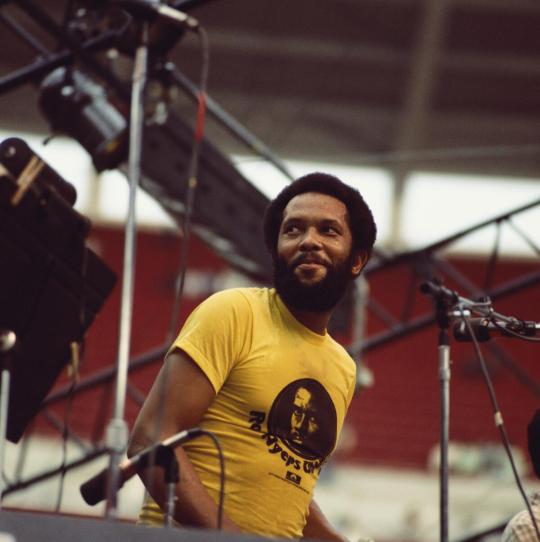
Roy Ayers
Jazz-soul vibraphonist and band leader best known for his laid-back summer track Everybody Loves the Sunshine
When Ruby Ayers, a piano teacher, took her five-year-old son Roy to a concert by the Lionel Hampton Big Band in California in 1945, the boy showed so much enthusiasm for the performance that Hampton presented him with his pair of vibe mallets. Roy Ayers, who has died aged 84, would go on to blaze a trail as a vibraphonist, composer, singer and producer.
A genre-bending pioneer of hard bop, funk, neo-soul and acid jazz, Ayers was most famous for his feel-good track Everybody Loves the Sunshine, from the 1976 album of the same name.
He said that the song was recorded at Electric Lady Studios in New York on, naturally, a warm summer’s day. Among those who feature are Debbie Darby (credited as “Chicas”) on vocals and Philip Woo on piano, electric piano and synthesizer. Woo explained that Ayers did not like to work from charts or scores, with the song based around a single chord that the band in the studio then developed.
While it was never released as a single, Everybody Loves the Sunshine’s warm, jazz-soul sound has won it numerous admirers over the past 50 years. As well as being sampled hundreds of times, by artists including Dr Dre and Mary J Blige, the track has also been covered by musicians ranging from D’Angelo to Jamie Cullen.
Perhaps the sheer simplicity of the song’s structure explains its appeal to such a variety of musicians. The hazy chords set up a steady state condition that allows the performer room for manoeuvre. D’Angelo covered the song in sweaty desire; Cullen’s Live in Ibiza version is as light and moreish as your favourite ice-cream; the Robert Glasper Experiment cover is edgy, an exercise in deconstruction. Other notable versions include the electronica-infused track from the DJ Cam Quartet and the modern jazz take of trumpeter Takuya Kuroda.
Ayers was born in the South Park (later South Central) district of Los Angeles, and grew up on Vermont Avenue amid the widely admired Central Avenue jazz scene during the 1940s and 50s, which attracted luminaries such as Eric Dolphy and Charles Mingus. His father, Roy Ayers Sr, worked as a parking attendant and played the trombone. His mother, Ruby, was a piano player and teacher.
He attended Thomas Jefferson high school, sang in the church choir, and played steel guitar and piano in a local band called the Latin Lyrics. He studied music theory at Los Angeles City College, but left before completing his studies to tour as a vibraphone – or vibes – sideman.
His first album, West Coast Vibes (1963), was produced by the British jazz musician and journalist Leonard Feather. He then teamed up with the flautist Herbie Mann, who produced the “groove” based sound of Virgo Vibes (1967) and Stoned Soul Picnic (1968).
Relocating to New York at the start of the 1970s, Ayers formed the jazz-funk ensemble Roy Ayers Ubiquity, recruiting a roster of around 14 musicians. At this time he composed and performed the soundtrack for the blaxploitation film Coffy (1973), starring Pam Grier as a vigilante nurse. The Everybody Loves the Sunshine album was released under the Ubiquity rubric, reaching No 51 on the US Billboard charts, but making no impact on the UK charts.
His 1978 single Get On Up, Get On Down, however, reached No 41 in the UK. He also scored chart success with Don’t Stop the Feeling (1979), which got to No 32 on the US RnB chart and 56 in the UK. The track was featured on the album No Stranger to Love, whose title track was sampled separately by MF Doom and Jill Scott.
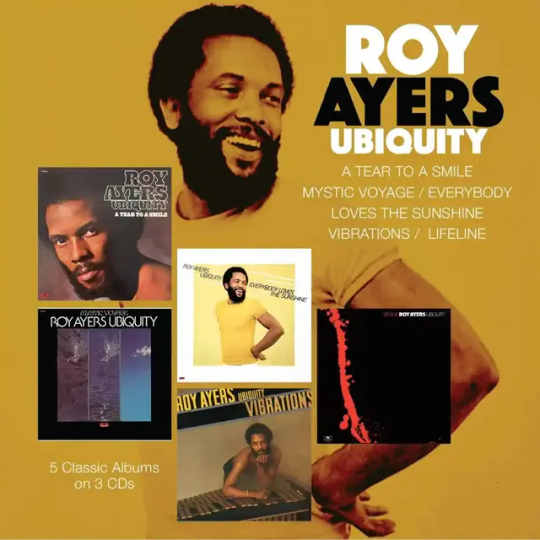
Ayers was a regular performer at Ronnie Scott’s jazz club in London during the 80s and his shows there were captured on live albums. Other live recordings include Live at the Montreux Jazz Festival (1972) and Live from West Port Jazz Festival Hamburg (1999). Ayers played at the Glastonbury festival five times, with his last appearance there in 2019.
A tour of Nigeria with Fela Kuti in 1979, and a resulting album, Music of Many Colours (1980), was just one of many fruitful collaborations. Ayers also performed on Whitney Houston’s Love Will Save the Day (1988); with Rick James on Double Trouble (1992); and with Tyler, the Creator on Cherry Bomb (2015).
A soul-funk album, Roy Ayers JID002 (2020), was the brainchild of the producers Adrian Younge and Ali Shaheed Muhammad. The latter was a member of the hip-hop group A Tribe Called Quest, who had sampled Ayers’ Running Away on their track Descriptions of a Fool (1989), and Roy Ayers Ubiquity’s 1974 song Feel Like Makin’ Love on Keep It Rollin’, from their 1993 Midnight Marauders album.
Ayers also collaborated with Erykah Badu on the singer’s second album, Mama’s Gun (2000). The pair recorded a new version of Everybody Loves the Sunshine for what would be Ayers’ final studio album, Mahogany Vibe (2004).
“If I didn’t have music I wouldn’t even want to be here,” Ayers told the Los Angeles Times. “It’s like an escape when there is no escape.”
Ayers married Argerie in 1973. She survives him, as do their children, Mtume and Ayana, a son, Nabil, from a relationship with Louise Braufman, and a granddaughter.
🔔 Roy Edward Ayers Jr, musician and band leader, born 10 September 1940; died 4 March 2025
Daily inspiration. Discover more photos at Just for Books…?
7 notes
·
View notes
Text



Spring, 1968: Elvis and Bobby Dick, a local Los Angeles musician member of the rock band The Sundowners. Bobby's band was a support act for The Monkees on their 1967 Summer Tour and his band also opened gigs for megabands such as The Rolling Stones and The Who in the 60s/70s. In these pictures, Elvis and Bobby were in front of the office building on Sunset Boulevard, Los Angeles, California, where Elvis had a meeting with Steve Binder about the upcoming NBC TV Special (Singer Presents Elvis A.K.A '68 Comeback Special).
Bobby talked about meeting Elvis. You can watch the interview on Youtube (Skip to 40:48). I recommend you take your time. ♥
youtube
Bobby said he was so nervous he was shaking and didn't ask Elvis the meaningful questions he really wanted answers for - about Elvis' choice of music in the 60's being so out of character for him and why he weren't doing recording better songs. Instead, Bobby says he looked more like "a babbling idiot" because he was starstruck, and didn't say much of what he truly wanted to. Funny. Those pictures surely don't look like Bobby was nervous at all.
Sadly, Bobby Dick passed away in March 27, 2023, at 76 years old, after a battle with cancer. Rest in peace, Bobby. ♥
#elvis presley#elvis the king#elvis fans#elvis fandom#60s elvis#elvis '68 comeback special#elvis#ep#musicians#60s music#rock and roll#60s rock and roll#Youtube
96 notes
·
View notes
Text

I PRESENT TO YOU -> MY RECORD COLLECTION:
1989 (Taylor's Version) (2023) - Taylor Swift
A Day At The Races (1976) - Queen
All Systems Go (1987) - Donna Summer
Azra (1980) - Azra
Berlin (1973) - Lou Reed
Besane noći (1988) - Magazin
Bitanga i princeza (1979) - Bijelo Dugme
Blonde on Blonde (1966) - Bob Dylan
Born to Run (1975) - Bruce Springsteen
Boy (1980) - U2
Ćiribiribela (1988) - Bijelo Dugme
Bridge Over Troubled Water (1970) - Simon and Garfunkel
Bringing It All Back Home (1965) - Bob Dylan
Eto! Baš Hoću! (1976) - Bijelo Dugme
The Freewheelin' Bob Dylan (1963) - Bob Dylan
Gore iznad oblaka (1987) - Tutti Frutti Band
Grupa Zana (1988) - Zana
Hajde da ludujemo (1990) - Tajči
Live At The Bowl '68 (1987) - The Doors
Hejira (1976) - Joni Mitchell
Help! (1965) - The Beatles
Kick (1987) - INXS
Magical Mystery Tour (1967) - The Beatles
Nebeske Kočije (1988) - Novi Fosili
Paket aranžman (1981) - Električni Orgazam, Idoli, Šarlo Akrobata
Pearl (1971) - Janis Joplin
Pokvarena mašta i prljave strasti (1981) - Riblja Čorba
Primitive Cool (1987) - Mick Jagger
Prodavnica tajni (1988) - Bajaga i Instruktori
Rank (1988) - The Smiths
Revolver (1966) - The Beatles
The River (1980) - Bruce Springsteen
Rubber Soul (1965) - The Beatles
Sgt. Pepper's Lonely Hearts Club Band (1967) - The Beatles
Speaking in Tongues (1983) - Talking Heads
Street Legal (1978) - Bob Dylan
Šta bi dao da si na mom mjestu (1975) - Bijelo Dugme
The Times They Are A-Changin' (1964) - Bob Dylan
Tonight (1984) - David Bowie
True Blue (1986) - Madonna
The Wall (1979) - Pink Floyd
Živo i akustično (1996) - Električni Orgazam
41 notes
·
View notes
Text




Stephen Stills, Henry Diltz, and Micky Dolenz staying at the same hotel during The Monkees summer tour, 1967
42 notes
·
View notes
Note
How and why did Elvis go down hill so fast after the Aloha from Hawaii concert

ahh this is a really interesting question, thank you for the ask <3 !! also I’m sorry if I didn’t interpret this correctly and if you mean’t the immediate aftermath of the special, I kind of answered in terms of the long run 😭
now this might be an unpopular opinion but I don’t believe that Elvis actually ever went ‘downhill’ at a constant or steady rate
Many fans, biographers, and reviewers sort of see the Aloha special as ‘past the point of no return’ for Elvis, meaning they see it his last moment of “greatness”, or the last moment where he was truly on top
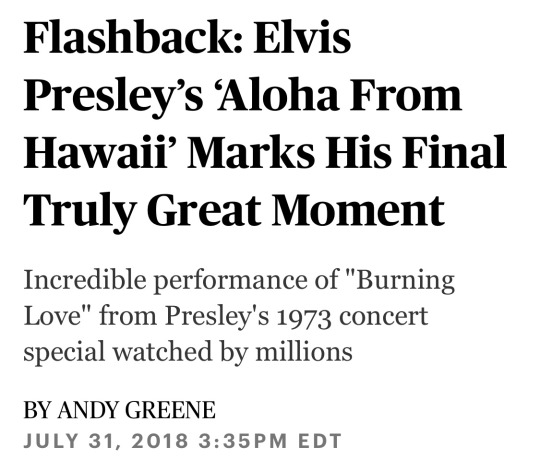
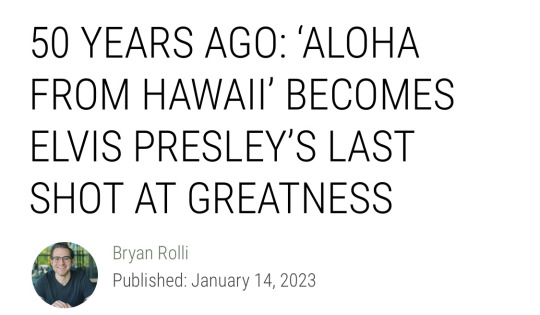
The Aloha special was no doubt a peak moment for Elvis, but I don’t definitely don’t view it as his “final truly great moment”. I also don't see the special as him reaching the top of the mountain and then next 4 years are him going down it. I see the special as one peak of many, in fact I think he continued to have peak moments up until his passing, which is why the suddenness of his death is so tragic because I don’t believe he was done. He was of course physically not well but not to the point that he wouldn’t have been able to overcome it if he had more time and proper care
Another reason that I can’t say he ever steadily declined is because that throughout his career, particularly in the 60s and 70s, Elvis had periods of highs and lows that often coincided with how his personal life was going i.e family, friends, girlfriends etc.etc
For example the tail end of the summer in 1976 was a particularly rough patch for Elvis. His health was declining, his relationship with Linda was on its’ last legs, his group was split (Dave, Red and Sonny had been fired), and Doctor Nick even stopped being his physician after a fallout had occurred and Doctor Elias Ghanem stepped in
Doctor Ghanem was even more neglectful in taking care of Elvis and as a result Elvis was loaded up on anti-depressants, sleeping pills, and other extremely debilitating narcotics. He was rendered almost completely incontinent. Thus resulting in one of Elvis’ worst tours yet, and one of his worst rated shows ever aka ‘Houston we have a problem’ which was taped on August 28th 1976
Reportedly Elvis was slurring and stumbling so badly on stage that several fans walked out, one reviewer even noted fans crying as they left
“People had witnessed the side effects from Elvis's medications during his performance in Houston. Elvis had taken Sparine (for depression), which contributed to muscle and speech problems. It knocked the bottom out of him, dropped his blood pressure. He couldn't do diddly-squat”
excerpt from the book “The King and Dr. Nick” by George Nichopoulos
It was one terrible show/performance after the next and Elvis was pushing himself to the limits and suffering because of it. According to band members Elvis had to be convinced to go on stage because he was so worried about disappointing the crowd. He wanted to perform better but his body physically wouldn’t let him. It was so terrible that just after 3 days of Elvis being under Doctor Ghanem’s care, Doctor Nick was called back and began working again to regulate Elvis’ prescription use
And then on November 19th, 1976, Elvis met 20-year-old Ginger Alden, and to just say he had “improved” would be a massive understatement. He began performing like he hadn’t been for years, resulting in one of his best tours, and some of his best shows such as his New Year’s Eve performance on December 31st, 1976. And more than just his career/shows, Elvis’ mood had visibly lifted, he was out of his depression and he was much more optimistic for the future
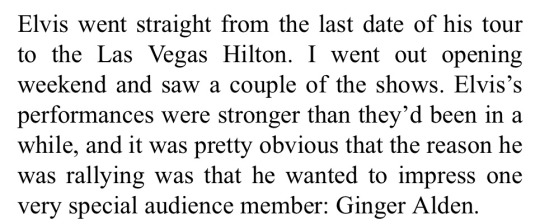
excerpt from the book “Elvis: My best man” by George Klein

excerpt from the book “If I can dream” by Larry Geller
So Elvis went from having one of his worst-rated concerts, to one of his best-rated concerts in just the span of a few months, which again proves to me at least that his “decline” wasn’t steady
When he was motivated and inspired, he could do incredibly great things, whether that motivation came from a single girl he wanted to impress in the audience or billions of people around the world like in the Aloha special
And this pattern can be seen throughout his career
Like in the 60s where Elvis would tend to let himself go a little bit between films and then when a script was given for his next picture, he would find the motivation to get back “in shape”, even reducing the amount of prescriptions pills he was taking in order to do so
But even the films eventually grew tiresome and Elvis didn’t find that motivation for his career again until the 68 comeback special. dontbeecruel breaks down the lead up to the special like Shakespeare I swear- please take the time to read it for yourself if you haven’t (it’s amazing) 😩 ⬇️
Another instance in the 70s where Elvis was able to recover from a low/downhill period and rise again was after his divorce with Priscilla. His saving grace, inspiration, and motivation this time came to him as Linda Thompson

excerpt from the book “A Little thing called Life” by Linda Thompson
The divorce undoubtedly caused was one of the lowest periods in Elvis’ life. He began taking pills and prescriptions that he had never had before such as Demerol and Dilaudid, his behavior became more erratic than ever, and he was in a deep depression, resulting in the decline of both his physical and mental health
It took him a while to recover but he eventually did, and I do honestly credit that to Linda’s presence in his life as she helped him move on

excerpt from “A Little thing called Life” by Linda Thompson
This decline and then rise can even be seen physically ⬇️
Left: Elvis in 1973, the day his divorce was finalized, where Priscilla says she was stricken by his appearance and worried for his health
Right: Elvis in 1974, visibly healthier, and performing in one of his best shows of a incredible tour

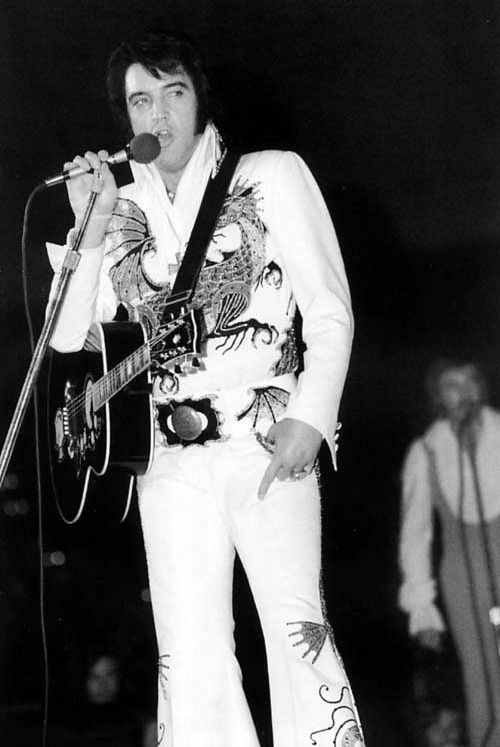
So again, Elvis went from enduring one of the worst periods of his life, declining mentally and physically, to improving and performing at his best again… all within the span of a year
I guess that’s why it breaks my heart when people act like Elvis’ last great moment was at 38 in the Aloha Special, and then every year after that was just downhill. He was always singing his heart out as best he could, even towards the end, and again, if his career was managed in his best interest and if his doctors acted in his best interest, I believe he would have many more moments like the Aloha special, he just wasn’t given enough time to do so

#I hope this made sense 😭#thank you again for the ask#I would love to hear what you guys think#as always please feel free to share any opinions <3#elvis presley#elvisaaronpresley#elvis#elvis history#elvis fans#elvis asks#70s#70s Elvis
56 notes
·
View notes
Text

The Monkees having some fun during their Summer of 1967 tour.
107 notes
·
View notes
Photo
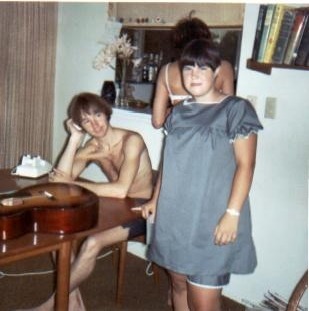
A fan named Cathy meeting Peter Tork in 1967; photo via Cathy's blog.
"While most girls loved Davy, I had a 15 year old girl true love for Peter.
In 1996 I saw them again (minus Michal [sic] Nesmith) on their Reunion Tour while living in Reno, Nv. Davy was wearing a cast on his leg and had to sit on a stool a good bit of the time. But I didn’t care. I was 16 years old again and being taken to another place and time by the Monkees and their music.
[...] I was head over heals [sic] 'ga ga' for Peter Tork of the Monkees. Most girls loved Davy but I loved Peter. Jimmy [sic] Hendrix commented on several occasions that Peter was the 'most talented one of the Monkees.[']
My mother knew that Peter was my obsession. She knew someone with the record label and was able to get the address to his home. We got in her dark green convertible MGB and drove up into the Hollywood Hills. She said she had a surprise for me. We pulled up in front of a really cool house and parked across the street. She told me this was the home of Peter Tork. She said I could go up to the door and ask for him autograph and to take a picture with him.
I was terrified….a pretty common state for me …but even more so that day. I froze. My mother was annoyed and finally coaxed me out of the car. I followed her across the street. She knocked on the door. Terror…Panic…What if I pass out or say something really stupid.
We waited. A young woman came to the door (in a white bikini bathing suit-not underwear.) My mother told the young woman that it was my 16th birthday and what we wanted. She invited us in. She took us into the room where Peter was on the phone. He stopped and listened to what we wanted. He talked to me for just a minute. I was too terrified to talk. I must have said something, but I am still not sure what it could have been. My mother took some pictures and Peter gave me hug. I couldn’t speak. This picture is the only one I have. Claudia kept this one and gave it to me when she found out I didn’t have them any longer. The other pictures and the postcard with his picture he autographed for me were lost during my 'drinking days.'
So that is the saga of my 16th birthday. It was truly a summer of change for me. For the first time, I was away from the tight-fisted control of my grandmother and my alcoholic grandfather. I started the school year with a new-found courage and belief that I was just maybe a little bit special." - Cathy, Cathy's Voice Now, February 29, 2012 [x]
#Peter Tork#Tork quotes#60s Tork#Monkees fans#The Monkees#Monkees#1967#Tork fan photos#long read#Tork fan recollections#not a fan of home addresses being given out and of people just showing up at the doorstep though#can you queue it
54 notes
·
View notes
Text
Portmeirion
Portmeirion in Gwynedd, North-West Wales, a two-and-a-bit hours drive from Liverpool has a bit of interesting Beatles history attached to it. It was designed and built by Sir Clough Williams-Ellis between 1925 and 1975 as an Italianate style village. He drew inspiration from a range of architectural styles, from classical and Gothic to Romanesque and Egyptian, to create the unique and eclectic village that stands to this day. (Watch him talk about the village here)
He was an advocate of rural preservation, amenity planning, industrial design and colourful architecture. "I think that Beauty, The Strange Necessity - as Rebecca West once called it - is something that matters profoundly to humanity, and that unless the race of man perishes from the earth, it will increasingly value that Grace, will seek it, and will ultimately attain it." - Sir Clough Williams-Ellis
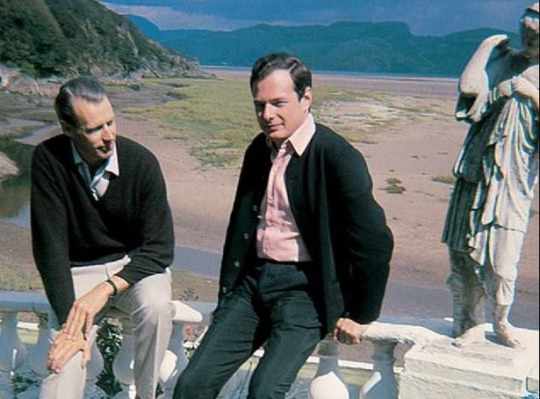
Brian and George Martin visiting Portmeirion, 1966
Brian Epstein holidayed here often with family and friends, staying frequently until his death in 1967. Portmeirion was an important place of retreat for him. At the start of August 1966, Brian went there to recuperate from a serious bout of glandular fever after his doctor prescribed a quiet vacation to rest and recover from the intense stress he was under, among other physical ailments recieved during the tour.
Brian became good friends with Williams-Ellis. Staying in the Gatehouse cottage, close to the entrance to the village, Brian suggested that the property might benefit from a dining room where he could entertain guests. Sir Clough duly obliged, building a large and ostentatious room not entirely in keeping with the original cottage. Not only that but the fashion conscious Brian once commissioned a renovation of his room at the Gatehouse having complained that there was not enough space for his clothes when he came to stay in his cottage every summer.

Brian's room in the Gatehouse with wardrobes made to his design (photo: Alli Devine)
““He went to convalesce in Portmeirion, North Wales ... There he invited George Martin as a guest. The two men spent much time devising an idea for a new television series on pop music to rival the BBC’s existing Juke Box Jury. The essence of their programme was that a jury had to guess what the chart ratings were going to be each week. The live programme was to be geared to when the charts of the week were revealed, so that only the presenter would know the record positions. Epstein and Martin took the idea to the BBC’s Bill Cotton Jr. ‘Brian was terribly enthusiastic about it,’ says George Martin, ‘But Bill Cotton didn’t think it was worthwhile. He was working on another programme at that time.’ The Epstein/Martin programme had a suggested title of Pick the Pops.
Brian told his mother from Portmeririon by telephone that he was bored, that a break was essential before his forthcoming American trip. But his boredom and enforced rest had lasted a weekend when a phone call from Nat Weiss forced him back to reality.” The Man Who Made The Beatles, by Ray Coleman
“He went by himself to a luxury hotel in Portmeirion on the North West coast of Wales that overlooked the Sea, and wind-swept beach, as remote a place as you could get from London. Everyone’s adcice was the same: try not to worry.” He had been there only four days before uproar errupted over John’s Jesus comments. Brian left Portmeirion right away to soothe the chaos.
“At the time, Brian was in Portmeirion, Wales, and he was ill. As the evening went on and I was getting all these calls, I called Portmeirion in the middle of the night and said, 'Something has to be done about this.’ And he said, is it serious?’ And I said, 'I think it’s so serious that you have to come over here.’The next day he flew over and I met him at the airport. The first thing he said to me was, 'How much would it take to cancel the tour?’ And I said, ‘I don’t know. Maybe a million dollars.’ He was so concerned about anything happening to any of the Beatles.” Nat Weiss, In My Life: The Brian Epstein Story by Debbie Geller
Patrick McGoohan chose the village as the setting for his TV series the Prisoner, which started shooting there in 1966 (he had filmed scenes for an earlier series there too, Danger Man, known as Secret Agent in the US). The Beatles were fans of the show, enjoying it's other-worldly setting, intriguing concept and the anti-establishment struggle of the lead character. George mentioned the Prisoner in his book, I Me Mine. Paul has reportedly stayed there, and Mike McCartney has also stayed there and loves it.
George Harrison loved Portmeirion and famously celebrated his 50th birthday in the village in February 1993. George originally wanted to stay in the Watch House, one of the village's most popular cottages which is high up on the cliff side of the upper part of the village. However the Watch House only has a low wall around it so his security men persuaded him to stay in the much safer Peacock Suite of the main hotel, where Brian had entertained dinner guests all those years ago.
It was also during this stay in Portmeirion that George was filmed for several interviews which were used in the The Beatles Anthology and had some pictures taken in the mirror room.
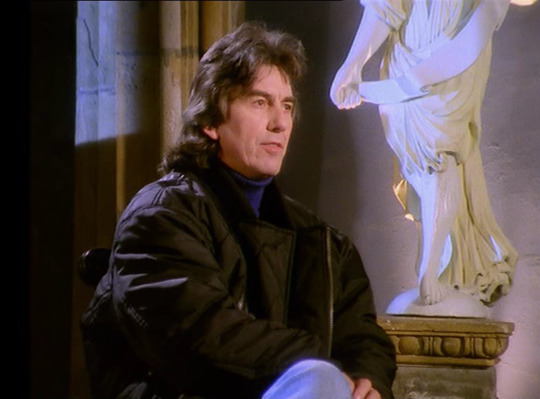

More footage of the place + Beatles history here.
#there you go 👍#Brian Epstein#George Harrison#George Martin#Brian#George#Nat Weiss#Quotes#Sir Clough Williams-Ellis#Portmeirion#queued
58 notes
·
View notes
Text
i need to work on my evil and horrible bob robbie story and i want to but lately im just never on my computer at all and i have a few twisted and horrendous ideas for other stuff but i always just write in my little idiot notebook. ah well.. big things on the way but i might need to buy a different laptop first so i can carry it with me places. anyhow im studying monkees uk us summer tour 1967 quite extensively now but...man one thing at a time now!! xo
5 notes
·
View notes
Text
Yellow Submarine
The sixth instalment of The Beatles mythology — and a project that barely involved them — was an animated fantasy film. Except for a single live action shot, a few new songs, some loose suggestions, and heaps of inspiration from their body of music (as well as from John's published writings), The Beatles were mostly hands-off with the production.
The Beatles' third United Artists feature, Yellow Submarine, arrived in theatres on 17 July 1968 (while the group themselves were still in the early stages of recording the White Album and already starting to lose steam). Inspired by a song they'd released two summers prior, the film uses select Beatles songs (all recorded since Help! but prior to the White Album; some brand new, most having been previously released) to weave a surreal narrative starring psychedelic cartoon Beatles — not the cartoon Beatles of Saturday morning fame, the shallow caricatures of their Hard Day's Night / Help! personae with bad accents, lame jokes, exaggerated physical features, and a limited shelf life overall. That's why the band wanted very little to do with this new animated iteration. But when they saw the film, they were reportedly pleased, and even regretted not having been more involved. For these new cartoon Beatles were the hip “turned-on” Beatles.
The group's YS portrayal embodies the living public personae they had cultivated since then, as a band and as individuals: John as the precocious intellectual, Paul the cute heartthrob, George the stoic mystic, and Ringo ever the neerdowell protagonist. Although the YS Beatles' personalities are certainly sourced from elements of the real-life foursome (circa 1967), these exaggerated depictions ultimately function according to their own principles, encapsulating the vibe throughout the Sgt. Pepper / Summer Of Love period and distilling an idealised view of The Beatles as heroes. While it makes up for the enigmatic, meandering nonesuch of Magical Mystery Tour (and puts it rather into perspective), by the time of the film's release these new cartoon Beatles were already slightly out-of-date with their real life post-India, Apple Corps, White Album counterparts (though not nearly to the same degree as the Saturday morning Beatles, who were forever locked into the naive clownfoolery of A Hard Day's Night and Help!).
The plot pits these post-Fab enlightened Beatles on a quest to rescue Pepperland from the oppressive boredom, melancholy, and humourless toil of the Blue Meanies (and their drab crabby Apple Bonkers, Snapping Turks, and other unsavoury villains). In the end, the story plays out like a Goon Show adaptation of Homer's Odyssey as illustrated by Peter Max. In other words, peak Beatle humour.
The YS portrayal of The Beatles has lasting repercussions not only for how the band are perceived for the remainder of their career (and how they perceive themselves), but also how the preceding portion of their career is reinterpreted. Yellow Submarine bridges the gap since Help!, with Rubber Soul and Revolver (previously grouped with Help!) now linked to Sgt. Pepper's Lonely Hearts Club Band and Magical Mystery Tour — appropriate since these four releases comprise their album-concept-oriented approach to studio recording (and also covers their entire LSD period) — while the The White Album, on it's face a more straight ahead album, could easily be reckoned as the demented carousel at Sgt. Pepper's concert; and Abbey Road constitutes an elegant musical recapitulation of the animated film's themes.
Broadly speaking, rather than rewrite or redefine their A Hard Day's Night personae, Yellow Submarine deepens them by expressing (and codifying) in story, visuals, and music the band's underlying philosophy about Love, Friendship, Humour, Joy, Fun, Laughter, and Singing The Blues Away that underpins their entire musical career.
[More to say, I may have, but a good start, this is.]
🍏
#the beatles#beatles fandom#john lennon#get back#ringo starr#george harrison#paul mccartney#paulmccartney#georgeharrison#george martin#mythology and folklore#yellow submarine#ringostarr#united artists#pepper#magical mystery tour#rubber soul#revolver#sgt peppers lonely hearts club band#sgt. pepper's lonely hearts club band#the goon show
7 notes
·
View notes